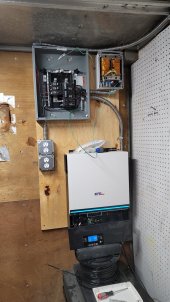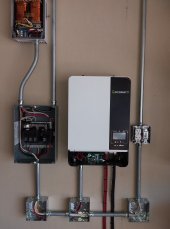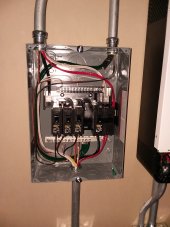ibkickinit
New Member
- Joined
- Jan 25, 2021
- Messages
- 4
Hi all,
Just installed a system at my property and hitting a strange issue. I have a 48v Battery Bank, an MPP Solar 8048 MAX (230v only), and an SE-5000 Autotransformer to generate a neutral. 100-Amp Breaker Panel. 50-Amp 2-pole breaker for L1/L2 coming from the inverter into the panel, with the Inverter Ground connected to the Panel Ground Bar. Ground and Neutral Bars are bonded in the panel. The Autotransformer has L1/L2 wired to a 30-Amp 2-Pole breaker, and the Neutral connected to the Neutral Bar.
When the Inverter turns on and the breakers are off, everything is works fine. I can meter 230v at the Inverter. I turn on the Main 50-Amp breaker, nothing changes (nothing connected still). Then when I turn on the 30-Amp for the Autotransformer, the Inverter immediately throws an F05 Short Circuit error.
Tried separating the Inverter Ground from the Neutral Bar, no change. Not alot going on here, but kind of stuck. Anyone have ideas?
Just installed a system at my property and hitting a strange issue. I have a 48v Battery Bank, an MPP Solar 8048 MAX (230v only), and an SE-5000 Autotransformer to generate a neutral. 100-Amp Breaker Panel. 50-Amp 2-pole breaker for L1/L2 coming from the inverter into the panel, with the Inverter Ground connected to the Panel Ground Bar. Ground and Neutral Bars are bonded in the panel. The Autotransformer has L1/L2 wired to a 30-Amp 2-Pole breaker, and the Neutral connected to the Neutral Bar.
When the Inverter turns on and the breakers are off, everything is works fine. I can meter 230v at the Inverter. I turn on the Main 50-Amp breaker, nothing changes (nothing connected still). Then when I turn on the 30-Amp for the Autotransformer, the Inverter immediately throws an F05 Short Circuit error.
Tried separating the Inverter Ground from the Neutral Bar, no change. Not alot going on here, but kind of stuck. Anyone have ideas?






